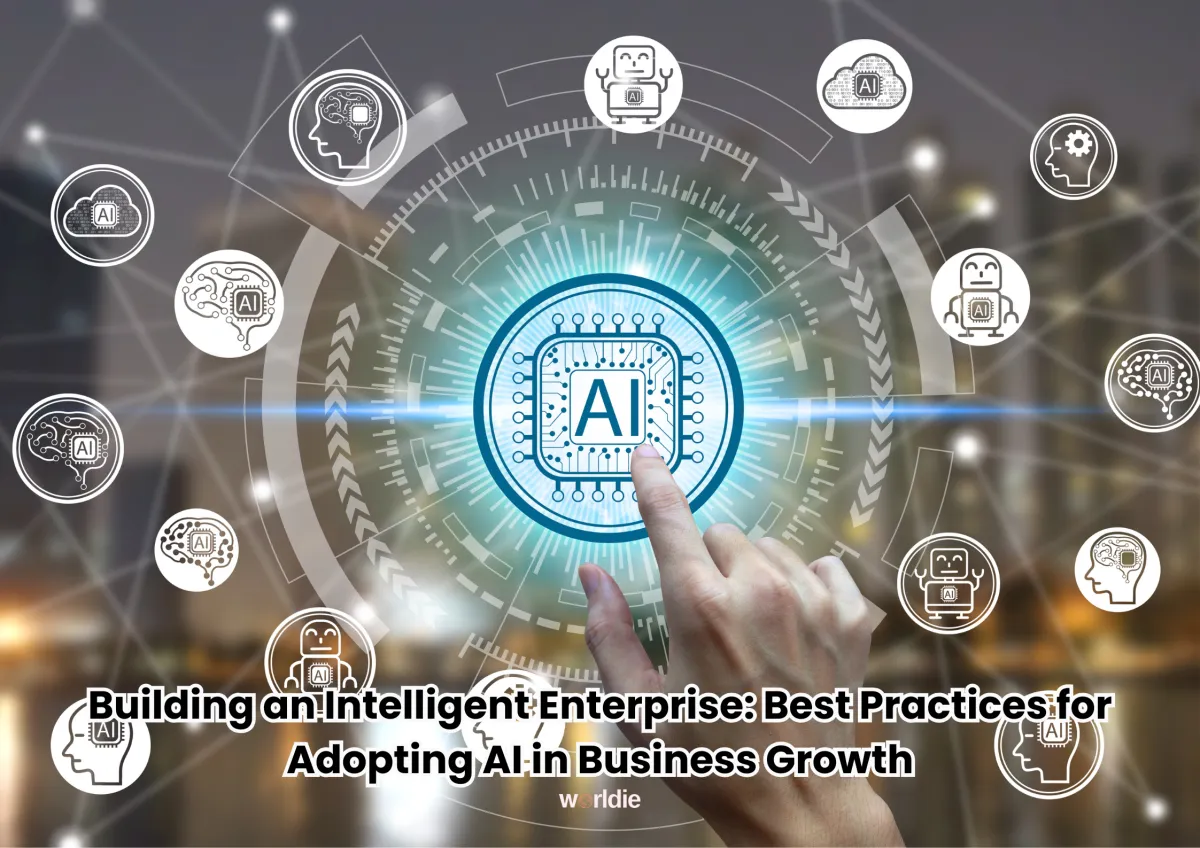
Building an Intelligent Enterprise: Best Practices for Adopting AI in Business Growth
Artificial Intelligence has moved beyond being a buzzword — it’s now a measurable growth driver reshaping how modern businesses operate, scale, and compete. The concept of best practices for adopting AI in business growth centers on building a foundation that aligns technology with strategy, ensuring that AI adoption doesn’t just automate tasks but transforms entire systems for profitability and efficiency.
For many organizations, AI still feels complex or distant. Yet those who have embraced it strategically are seeing exponential benefits — faster decision-making, higher customer satisfaction, reduced operational waste, and predictive business intelligence that drives continuous growth. The real question is no longer if a business should adopt AI, but how it should approach it intelligently, systematically, and sustainably.
At Worldie AI, this process begins with a single mindset shift: AI is not an add-on. It is an evolution of how your business thinks, learns, and grows.
Understanding What AI Adoption in Business Growth Means
AI adoption in business growth refers to the intentional integration of artificial intelligence technologies into an organization’s workflows to optimize performance, enhance decision-making, and unlock new sources of value. This includes machine learning systems that predict outcomes, automation tools that streamline processes, and intelligent data models that learn from behavior to continuously improve efficiency.
Many companies make the mistake of seeing AI as a plug-in — a single tool meant to handle one function. True adoption means embedding AI into the fabric of business strategy. When done right, AI doesn’t just automate—it amplifies human capabilities. It helps executives forecast demand, marketers understand intent, operations teams predict bottlenecks, and finance departments detect inefficiencies before they become losses.
AI adoption is less about replacing jobs and more about augmenting intelligence. It gives teams the ability to move from reactive decision-making to proactive, data-driven strategy.
Why Businesses Struggle to Adopt AI Successfully
Despite its potential, many businesses find AI adoption harder than expected. The challenge rarely lies in the technology itself — it lies in readiness. Companies often underestimate the foundational work required before implementation. Data scattered across systems, lack of internal AI literacy, and fear of organizational change often slow down progress.
Another common pitfall is starting with technology before defining a clear business case. Many organizations purchase AI tools without mapping out their goals or understanding the impact they expect to create. This leads to isolated experiments with limited ROI.
The path to successful AI adoption starts with clarity — identifying what problem needs solving, how AI will solve it, and how success will be measured. It’s not about chasing innovation for its own sake but embedding intelligence into the core of business growth.
The Inefficiencies Holding Modern Businesses Back
Every growing business faces invisible inefficiencies that limit scale. Manual data entry, fragmented tools, repetitive decision-making, and siloed systems all slow down performance. These operational bottlenecks drain time and resources, leaving teams to spend more effort managing systems than driving growth.
AI addresses these inefficiencies by connecting and optimizing the entire business ecosystem. Imagine a logistics company that no longer has to guess when shipments might delay — its AI model predicts potential disruptions based on traffic, weather, and previous delivery patterns. Or a professional services firm that no longer manually sorts leads — AI filters and ranks prospects based on their likelihood to convert, saving hours each day.
The beauty of AI adoption lies in its scalability. Once implemented effectively, intelligent systems continue to learn, adapt, and optimize over time, turning inefficiency into precision.
Practical Use Cases of AI Across Industries
AI adoption touches every sector in different ways, and its value grows with scale and integration.
In retail, AI analyzes customer behavior across multiple touchpoints, predicting buying intent and personalizing experiences. A clothing brand, for instance, can automatically recommend products based on browsing patterns and previous purchases, increasing both sales and customer satisfaction.
In finance, predictive AI models detect anomalies and flag fraudulent transactions in real-time. Risk assessment becomes more accurate, while compliance teams spend less time reviewing false positives.
Healthcare organizations use AI to identify early signs of disease, predict patient outcomes, and streamline appointment scheduling. Doctors can make better clinical decisions with data-backed insights, improving care and saving lives.
Manufacturing businesses deploy AI-driven maintenance systems that forecast when machinery needs attention, reducing costly downtimes and production halts.
These examples show that the power of AI lies not in isolated use cases but in how it connects intelligence across all levels of the business.
The Worldie AI Approach: From Design to Release
At Worldie AI, the process of adoption follows a precise and proven structure: design, build, and release. Each phase ensures that AI systems are strategically aligned with a business’s operational and growth goals.
The design stage focuses on understanding the organization’s ecosystem — its data, workflows, and challenges. Here, Worldie AI conducts detailed assessments to identify areas where automation, analytics, or intelligent prediction can deliver the most impact.
Once a blueprint is created, the build phase begins. This involves developing or customizing AI models, integrating them with existing systems, and ensuring they align seamlessly with real-world business processes.
Finally, the release stage is where strategy meets execution. AI solutions are deployed, tested in live environments, and continuously optimized. This cycle ensures every AI system Worldie AI builds is not just implemented but also evolves as the business scales.
Simplifying Complex AI Concepts for Decision-Makers
Many business leaders hesitate to dive into AI because the terminology feels overly technical. Yet the core principles are simple when explained through their purpose.
Machine learning helps systems recognize patterns and improve performance through experience. Natural language processing enables machines to understand and respond to human language. Predictive analytics uses historical data to forecast future outcomes, empowering leaders to make informed decisions before events occur.
Executives don’t need to understand algorithms — they need to understand how AI affects performance metrics, team productivity, and revenue potential. The key to adoption is reframing AI not as a technology investment, but as a business capability.
Best Practices for Adopting AI in Business Growth
The most successful AI transformations share a few critical practices that can guide any organization.
Every adoption begins with defining clear objectives. Businesses that identify the right goals — whether it’s optimizing lead generation, reducing costs, or improving forecasting — can measure progress and adjust strategies effectively.
Next comes data preparation. High-quality, well-structured data is the lifeblood of AI. Without reliable data sources, even the most advanced systems deliver weak results. Establishing data pipelines and cleansing mechanisms early ensures accuracy and consistency across operations.
Another essential practice is collaboration. AI adoption is not an IT project — it’s a company-wide initiative. Marketing, operations, finance, and customer success teams must work together to align insights and workflows. When departments collaborate, AI can truly act as the brain connecting all parts of the business.
Lastly, organizations should start small but think big. Testing AI with a focused use case — such as automating lead qualification or forecasting sales — helps build momentum. Once the system proves its value, expansion becomes natural and supported by data-driven results.
Challenges in Deploying AI Systems
Even with a strong roadmap, challenges can emerge during deployment. Integrating new AI systems with legacy software can create compatibility issues. Employees may resist changes due to fear of job displacement or lack of understanding.
Ethical considerations also arise, particularly around data privacy, bias, and transparency. Businesses must ensure AI decisions are explainable and fair.
The best way to overcome these challenges is through a mix of technical readiness and cultural leadership. Worldie AI focuses on education and engagement — training teams, communicating openly, and ensuring AI serves people rather than replacing them.
Key Metrics for Measuring AI Success
Success metrics must go beyond automation rates or cost savings. True AI adoption transforms performance indicators.
Businesses should measure revenue growth, operational efficiency, and the speed of decision-making. AI’s ability to reduce errors, shorten cycle times, and improve forecasting accuracy becomes tangible proof of progress.
For example, a logistics company may track the reduction in delivery delays after implementing predictive routing. A marketing agency might measure how AI-driven audience segmentation increases conversion rates.
Over time, these metrics reflect the compounding value of AI — efficiency today becomes innovation tomorrow.
How AI Transforms Organizational Culture
Adopting AI is not just a technical transformation but a cultural evolution. When data becomes central to decisions, organizations move away from guesswork and toward evidence-based strategies.
Teams start relying on insights, not assumptions. Creativity expands because manual repetition decreases. Decision-making becomes faster and more confident.
Cultural transformation happens when leadership communicates the value of AI with transparency and vision. Employees feel empowered rather than threatened, understanding that AI is a partner in progress.
How Worldie AI Accelerates Business Transformation
Worldie AI stands at the intersection of intelligence and execution. Its mission is to help organizations transition from manual, reactive operations to fully intelligent business ecosystems.
The company’s expertise spans automation design, AI system engineering, and scalable infrastructure deployment. Whether building intelligent analytics for enterprise operations or developing custom conversational agents, Worldie AI delivers solutions that directly connect to measurable outcomes.
Every implementation is grounded in ROI and built for adaptability, allowing businesses to evolve their systems as they grow. Worldie AI doesn’t just integrate AI — it architects transformation.
Looking Ahead: The Next Evolution of AI Adoption
The future of AI adoption lies in continuous learning systems that adapt in real time. Businesses will move from analyzing data retrospectively to predicting outcomes continuously.
Imagine an AI-powered environment where operations, marketing, finance, and customer service all operate under a unified intelligence layer. Decision-making becomes autonomous, and insights are generated before human teams even ask for them.
Companies that start integrating AI now will lead this next wave of intelligent business evolution. Those that delay will find themselves reacting to smarter competitors.
Five FAQs About Best Practices for Adopting AI in Business Growth
1. How long does it take to see measurable outcomes from AI adoption?
The timeline varies depending on data readiness, business complexity, and the scope of integration. Some organizations experience improvements within a few weeks, while others may take several months to realize full-scale impact.
2. What’s the biggest factor behind successful AI adoption?
Clear objectives and data quality play the most critical roles. When businesses know what they want to achieve and ensure their data supports that goal, AI becomes far more effective and scalable.
3. Can smaller businesses successfully implement AI without massive budgets?
Yes. Many AI platforms today are modular and accessible. Small and mid-sized businesses can begin with targeted automations or predictive systems, then expand as value compounds. Worldie AI helps design systems proportionate to each organization’s growth stage.
4. How can companies manage employee resistance during AI transformation?
Education, inclusion, and transparency are essential. When employees understand that AI enhances their roles rather than replaces them, resistance decreases. Worldie AI often conducts training programs to help teams adopt new systems confidently.
5. What makes Worldie AI’s approach different from other AI solution providers?
Worldie AI combines strategic consulting with full technical execution. Its design-build-release methodology ensures businesses don’t just install AI tools but integrate them into daily operations with measurable results tied to growth and revenue transformation.

